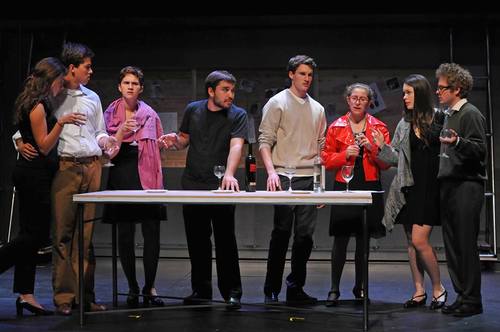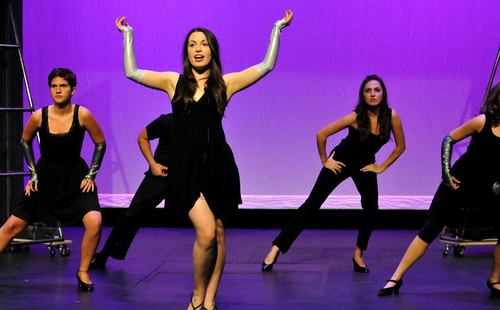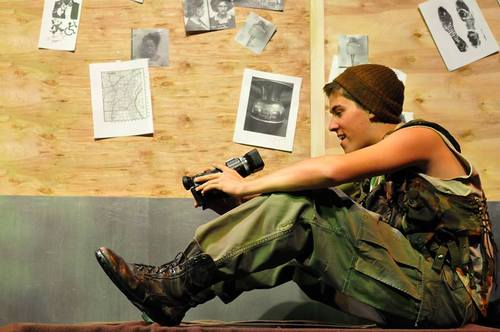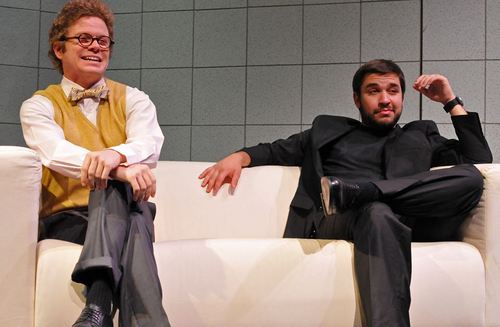One might wonder: what is the plot of a play without a plot? Ideas? Youth. Terrorism. Pornography. Pseudoegalitarianism. Abstraction!
Confusion? Good.
I have always been hesitant to watch dress rehearsals because of their almost inevitable lack of finality; however, the production I saw was not only prepared, but pleasurable and important. Thursday night, I was able to watch the final dress rehearsal of the infamous “plotless play” by Martin Crimp called Attempts on Her Life.
To try to explain the “what happens” of the play would not be pointless, but rather distracting from the more important how it happened, why it happened, and to what impact it served.
Crimp wrote a series of satirical vignettes that are directorially ambiguous and seemingly unrelated. This means two things: first, it is up to the director’s discretion to create (or not create) a basic storyline or theme that will be true to the text and be engaging for an audience; second, the directors better be damned good.
Fortunately for the comfort of the actors and the pleasure of the seven audience members in this dress rehearsal of Attempts On Her Life, the latter was absolutely the case.

Attempts on Her Life isn’t a play about a character; it is a play about how one might become that character. It portrays consumerism and media, offering one attempt at explaining the life of the seemingly absent, and yet central character “Anne.” Anne is alluded to as a popstar, a brand of car, a suicidal teenager, a traveler, a mother, a murderer, a poet, a lunatic, a little girl, a daughter, a terrorist, and porn star, and a heroine. Anne holds multiple “labeled” identities and each portion of the play examines a different one.
If this description seems abstract to you, the reason is probably because that’s exactly what the play is: abstract. Crimp wrote the play with no solid characters or stage directions, allowing the actors and directorial staff complete freedom. The script of the play is solely text divided into different scenes, forcing the ensemble cast to give it life.
While the play is dependent on its words, the performance transcended language. The vignettes were not rooted in plot, but rather in a general feeling or emotion that might surface when one hears someone gossiping about them, sees their daughter leave home, or realizes that they are living in the bounds of technology. From a personal standpoint, watching this play was a lot like reading ee cummings’ poetry. It doesn’t leave you with a message, but rather a feeling, or interpretation.
And interpretations are just as artistic as the art that evokes them. For me, Attempts on Her Life felt like the phrase “sunny, steel wool, and a psychiatrist.” That is, of course, open to your interpretation.
Abstractions aside, the play portrayed topics like pornography, suicide, commercial success, and terrorism as troubling. The actors used the text as a vehicle to force the audience to reflect on the society we live in, and the topics we deal with daily. The small, intimate audience felt uncomfortable and that is a sign of good theatre—and maybe even a sign of good art in general. For art to be considered provocative it has to resonate with those who watched it.
I found the vignettes so engaging that I tried to clap after each one of them, only stopping myself when I realized mid-play clapping isn’t proper experimental theatre protocol.

The talents of Kiki Bagger, Dante Belletti, Austin Caldwell, and Louis McWilliams knocked my socks off. Bagger was heavily featured in the production and if the play had a protagonist, it was she. She performed three of the more abstract poetic vignettes of the script that the directors turned into pop songs. Her rendition of “Girl Next Door” was glitter and whispers, as she slinked around the theater singing lines of text put to an original musical score by Claudia Barton.

The only monologue of the production was performed by Louis McWilliams playing an anarchist militant proposing an idea for a short film. McWilliams’s pacing was alternately frenetic and eerily calm. His portrayal of both eagerness and insanity gave his vignette an interesting balance, a character shift from relatable to lunatic.

Austin Caldwell acted with the maturity of a thirty-something and the youthful energy of an eleven-year old. His physicality and off-line reactions lit up every scene with a consistent commitment to an incredible range of roles. His part in the “art critic” scene made a great foil to Dante Belleti’s subdued, pretentiously cool character with a flair for flashy smiles and academic-sounding nonsense.
The production will leave experimental-theater-virgins uneasy in the best possible sense. I heard that the theatre department was originally going to do August Osage County for their fall show, until they decided that they wanted “a real challenge.” Experimental theatre is arguably always a challenge—or rather, a struggle to interpret the infinitely interpretable in a way that reaches and resonates with an audience. For Attempts on Her Life, that struggle was fought well.
Attempts on Her Life continues next weekend with shows at 8p on Thursday, Friday and Saturday. For tickets and other information, see here.
Photo credit Stanford TAPS Department
